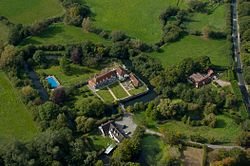Horselunges Manor
| Horselunges Manor | |
|---|---|
 Aerial view of Horselunges Manor | |
 | |
| General information | |
| Status | Completed |
| Type | House |
| Classification | Grade I |
| Location | Hellingly, East Sussex, England |
| Coordinates | 50°53′09″N 0°14′53″E / 50.88583°N 0.24806°E |
| Completed | Late 15th century |
| Renovated | 1925 |
| Technical details | |
| Material | Timber |
| Size | 1.5 acres (0.61 ha) |
| Grounds | 86 acres (35 ha) |
Horselunges Manor is a 15th-century manor house in Hellingly, East Sussex, that was restored in the 20th century. The house was previously owned by Peter Grant, the manager of Led Zeppelin, and featured in the film The Song Remains the Same about the band. Horselunges Manor is a Grade I listed building.
History[edit]
Horselunges manor flooded in October 2000 causing the house to be unhabitable for two years
Horselunges Manor was built in the late 15th century by John Devenish,[1] whose family owned the house for a number of generations.[2] The house is situated in Hellingly, East Sussex, around 300 metres (0.19 mi) from the parish church[3] and 2 miles (3.2 km) from Hailsham.[2] The name may have come from the phrase "Hurst-longue", which means "entrance into the wood".[4][dubious ]
In 1541, Thomas Fiennes, 9th Baron Dacre and his men were involved in an incident whilst poaching[5] near to Horselunges Manor,[6] during which a servant was killed.[5] Fiennes was hanged for the crime.[5] In the 20th century, Peter Grant, the manager of English rock band Led Zeppelin, lived at the house.[7] He paid £80,000 for the house, and spent an additional £10,000 on renovating the property.[6] The house featured in the film The Song Remains the Same about Led Zeppelin,[7][6] and Grant suggested basing Swan Song Records at Horselunges Manor.[8] In the 20th century, the estate was managed by Alfred Linforth Pitman, a veteran of the Battle of Dunkirk.[9][10] In 1952, the house became a Grade I listed building,[1] and it is currently a private residence.[11]
Architecture[edit]
Horselunges Manor is built of timber, and is a two-storey building.[1] The house has an area of 1.5 acres (0.61 ha),[2] and is surrounded by a moat,[1] and has a total of 86 acres (35 ha) of farmland.[6] It may have been built in a quadrangle, though only one side now remains.[11] The house is unusual in that the halls of the buildings do not have aisles.[12] The house was altered in the 16th century, which may have been when the original hall was removed from the house.[1] At that time, a staircase was added to the house.[1][2] In the 18th century, a stables was built adjacent to the house out of red brick.[1] Attached to the main house, there is a chantry chapel.[13] The house was restored in 1925 by architect Walter Godfrey.[1]
The west side of the estate has a walled garden; historically, the south side of the manor also had a walled garden, though the walls no longer exist. In the 20th century, there was a topiary garden, the remnant of which exist nowadays.[3]
References[edit]
- ^ a b c d e f g h Historic England. "Horselunges Manor (1285385)". National Heritage List for England.
- ^ a b c d Emery, Anthony (2006). Greater Medieval Houses of England and Wales, 1300–1500: Volume 3, Southern England. Vol. 3. Cambridge University Press. p. 357. ISBN 9781139449199. Archived from the original on 23 September 2021. Retrieved 18 September 2021.
- ^ a b "Horselunges Manor". Parks and Gardens. 2004. Archived from the original on 18 September 2021. Retrieved 18 September 2021.
- ^ Horsfield, Thomas Walker (1835). The History, Antiquities, and Topography of the County of Sussex. Vol. 1. Sussex Press. p. 318. Archived from the original on 23 September 2021. Retrieved 22 September 2021.
- ^ a b c "Fiennes, Thomas, ninth Baron Dacre". Oxford Dictionary of National Biography (online ed.). Oxford University Press. doi:10.1093/ref:odnb/9414. (Subscription or UK public library membership required.)
- ^ a b c d Blake, Mark (2018). Bring It On Home, Peter Grant, Led Zeppelin and Beyond: The Story of Rock's Greatest Manager. Little, Brown Book Group. ISBN 9781472126870. Archived from the original on 23 September 2021. Retrieved 18 September 2021.
- ^ a b "Hellingly". Heathfield News. Archived from the original on 23 September 2021. Retrieved 18 September 2021.
- ^ Wall, Mick (2010). When Giants Walked the Earth: A Biography Of Led Zeppelin. Orion Publishing Group. ISBN 9781409111214. Archived from the original on 23 September 2021. Retrieved 18 September 2021.
- ^ "Linforth Pitman obituary". The Times. 29 October 2018. Archived from the original on 18 September 2021. Retrieved 18 September 2021.
- ^ "Death at age of 102 of Dunkirk and desert hero". Sussex Express. 14 September 2018. Archived from the original on 18 September 2021. Retrieved 18 September 2021.
- ^ a b Chantler, Bob. Kent & East Sussex River Walks. p. 39. Archived from the original on 23 September 2021. Retrieved 18 September 2021.
- ^ Nairn, Ian; Pevsner, Nikolaus (2001). Sussex. Yale University Press. p. 279. ISBN 9780300096774. Archived from the original on 23 September 2021. Retrieved 18 September 2021.
- ^ Nibbs, Richard Henry; Lower, Marc Antony (1872). The Churches of Sussex. W.J. Smith. Archived from the original on 23 September 2021. Retrieved 22 September 2021.
